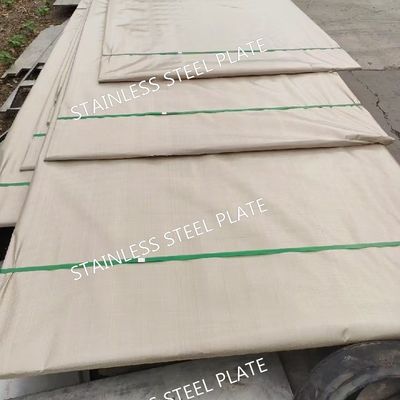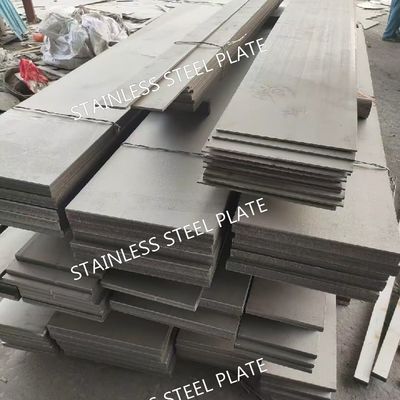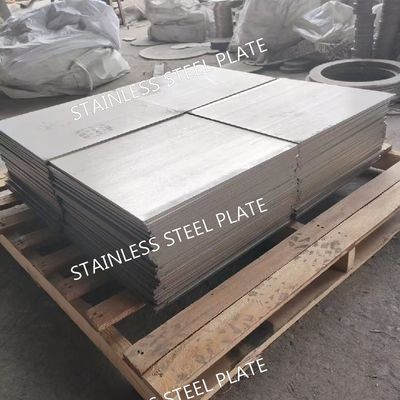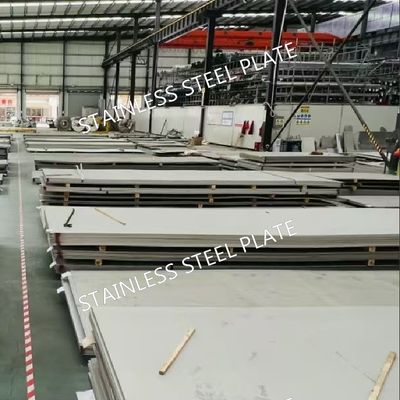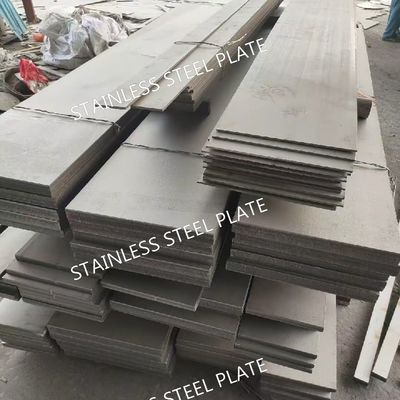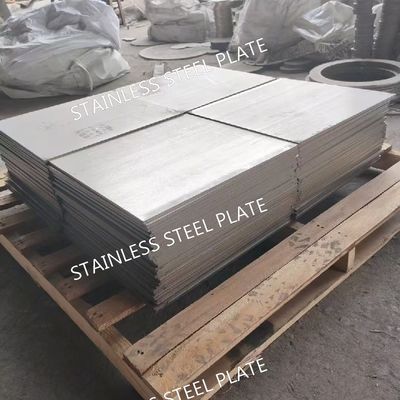-
Прокладка нержавеющей стали
-
Лист нержавеющей стали
-
Плита нержавеющей стали
-
труба нержавеющей стали
-
Адвокатура нержавеющей стали
-
Гальванизированная стальная катушка
-
Стальная пластина
-
стальной круглый бар
-
сплав никеля
-
Безшовная стальная труба
-
Луч нержавеющей стали
-
Лист медной плиты
-
Медная круглая Адвокатура
-
 Raian IonescuМатериальное качество очень хорошее. мы имеем объединить больше чем 10 лет. Они торгуют видами серий стального материала. Полностью материальное качество хорошее. Они обязанность для полностью материального качества. Мы строгаем для того чтобы продолжать объединить с ними в будущем
Raian IonescuМатериальное качество очень хорошее. мы имеем объединить больше чем 10 лет. Они торгуют видами серий стального материала. Полностью материальное качество хорошее. Они обязанность для полностью материального качества. Мы строгаем для того чтобы продолжать объединить с ними в будущем
High Corrosion Resistance 317L Stainless Steel Plate for Chemical Processing
| Место происхождения | Китай |
|---|---|
| Фирменное наименование | BAOSTEEL TISCO |
| Сертификация | ISO |
| Номер модели | 317L / S31703 |
| Количество мин заказа | 50 кг |
| Цена | 5 - 8 USD/Kg |
| Упаковывая детали | стандартная упаковка для экспорта |
| Время доставки | 5 - 12 дней на основе количества |
| Условия оплаты | Л/К, Т/Т, Вестерн Юнион |
| Поставка способности | 20ton в неделю |

Свяжитесь я бесплатно образцы и талоны.
Whatsapp:0086 18588475571
Wechat: 0086 18588475571
Skype: sales10@aixton.com
Если вы имеете любую заботу, то мы предусматриваем 24-часовую интерактивную справку.
x| Продукты | листы из нержавеющей стали | Оценка | 317Л/С31703 |
|---|---|---|---|
| Толщина | 1,0-80,0 мм | Технический | холоднокатаный, горячекатаный, кованый |
| Ширина | 1000mm 1219mm 1500mm или таможни как запрос | Поверхность | 2B БА No.1 |
| Стандартный | DIN EN ASTM GB JIS | минимальный заказ | 1 тонна |
High Corrosion Resistance 317L Stainless Steel Plate for Chemical Processing
Stainless Steel Sheet Specifications
| Name | 317L stainless steel sheet |
| Our Grade |
200 Series: 201 202 300 Series: 301 304,304L,304H,309S,310S,314,316L,316Ti,316H,316LN,317L,321,329,347 400 Series: 409L,410,410S,416,420,430,431,436L.439,441,443,444,445,446 Super Stainless Steel: 904L,926,254SMO,654SMO,15-5PH,17-4PH,17-7PH.etc Nickel Alloy: C276, C22,G35,Alloy X,Monel 400,K500,Inconel 600,601,617,625,718,Incoloy 800,800H,800HT,825.etc |
| Technique | Hot Rolled, Cold Rolled,Forged |
| Standard | JIS, AISI, ASTM, DIN, TUV, BV, SUS, etc |
| Thickness | 0.1 – 80.0mm |
| Width range | 10mm – 2000mm |
| Length | Customized |
| Finish | 2B, BA, No.4, 8k, Brushed,Hairline,PVD Coating,Sandblasted |
| Service | Laser Cutting, Bending |
| Sample | Available |
High Corrosion Resistance 317L Stainless Steel Plate for Chemical Processing
Introduction
In the demanding environments of chemical processing, material selection plays a critical role in ensuring longevity, safety, and efficiency. Among the many choices available, the alloy known as 317L stainless steel (also referenced as UNS S31703) stands out for its enhanced corrosion resistance, particularly in aggressive acidic and chloride-laden environments. This article explores in depth the composition, properties, fabrication, and application of 317L stainless steel plate—why it is especially suited for chemical processing, what makes it different from more common grades, and how to best deploy it.
Alloy Composition and Metallurgical Basis
The superior performance of 317L stainless steel derives primarily from its chemical makeup and microstructure. Compared to standard austenitic stainless steels such as grade 316L or 304/304L, 317L incorporates higher levels of chromium (Cr), nickel (Ni), and especially molybdenum (Mo) — elements that contribute significantly to corrosion resistance.
According to technical sources:
-
Chromium content: approximately 18.0 % to 20.0 %.
-
Nickel content: around 11.0 % to 15.0 %.
-
Molybdenum content: typically 3.0 % to 4.0 % (or sometimes cited as a minimum of 3 %).
-
Carbon content (for the “L” grade): maximum ~0.030 % (or low-carbon) to reduce sensitization risk during welding.
-
Other minor elements: manganese (Mn), silicon (Si), phosphorus (P), sulfur (S), nitrogen (N) in controlled amounts.
What do these alloying decisions accomplish?
-
Chromium forms a protective passive chromium-oxide (Cr₂O₃) film on the steel surface, providing resistance to general corrosion and oxidation.
-
Nickel stabilizes the austenitic structure (face-centred cubic lattice) which gives good ductility, toughness and weldability.
-
Molybdenum significantly enhances resistance to localized corrosion such as pitting and crevice corrosion — especially in chloride-containing and sulphur-bearing environments.
-
The low carbon (in “L” grade) minimizes carbide precipitation at grain boundaries during welding or high-temperature service, thereby protecting against intergranular corrosion.
In short, 317L is a high-alloy austenitic stainless steel optimized for demanding environments where corrosion, temperature, and weldability are all important.
Key Properties of 317L Stainless Steel Plate
Corrosion Resistance
The principal advantage of 317L lies in its corrosion resistance — both in general and in highly aggressive conditions. Some of the key points include:
-
Pitting and crevice corrosion resistance: Because of the elevated molybdenum and nickel content, 317L exhibits significantly improved resistance compared to 316L and standard austenitic grades. One source notes that the Critical Pitting Temperature (CPT) of 317L is typically 40-50 °C higher than that of 316L in standard chloride test solutions.
-
Resistance in acidic and chloride environments: 317L is often used in acidising, chloride-rich and sulphur-bearing environments. For example: "resists attack in sulphuric acid concentrations up to 5 % at 120 °F (49 °C)" was reported.
-
Intergranular corrosion / sensitization: The low carbon content of 317L helps mitigate the risk of carbide precipitation (chromium carbides) at grain boundaries during welding or high-temperature exposure — thereby maintaining corrosion resistance in the heat-affected zone (HAZ).
-
Oxidation / high temperature service: 317L exhibits good resistance to oxidation and scale formation at elevated temperatures — continuous service up to ~925 °C (1700 °F) has been reported, and intermittent up to ~879 °C (1620 °F) in some sources.
-
Stress corrosion cracking (SCC) resistance: While no austenitic stainless steel is completely immune, 317L has enhanced thresholds for chloride-induced SCC due to the combination of higher nickel and molybdenum.
Mechanical and Physical Properties
Beyond corrosion resistance, 317L offers suitable mechanical and fabrication characteristics for plate use in chemical processing:
-
Typical tensile strength: around 75 ksi (≈ 520 MPa), with minimum yield strength around 30 ksi (≈ 205 MPa).
-
Elongation: ≥ 40 % in many cases, indicating good ductility.
-
Thermal properties: Density ~ 7.8–8.0 g/cm³ (≈ 0.289 lb/in³) for the alloy plate.
-
Thermal expansion coefficient (20 – 100 °C): ~ 16.0 ×10⁻⁶/°C.
-
Good weldability and formability: As an austenitic stainless, 317L can be welded using common fusion and resistance methods (though with due attention to welding consumables and heat control).
Fabrication / Plate Availability
-
Plate thicknesses for 317/317L are commercially available in a wide range: e.g., from 3/16″ up to 4″ thick or more, depending on the supplier.
-
Fabrication processes such as plasma cutting, shearing, water-jet cutting, forming, welding, and machining are feasible for 317L grade plate.
Why Choose 317L Plate Specifically for Chemical Processing Applications?
Chemical processing plants pose a challenging environment for materials: exposure to acids, halides (chlorides, bromides, iodides), elevated temperatures, condensation of corrosive fumes, pressure, and cyclic service. The following reasons underscore why 317L stainless steel plate is an excellent choice for such applications:
-
Aggressive media tolerance: Equipment in chemical plants often handles sulphuric acid, phosphoric acid, organic acids, chloride-rich solutions, bleaching agents, oxidizing and reducing conditions. 317L’s enhanced alloying provides a safety margin beyond conventional 316/316L.
-
Localized corrosion resistance: Many failures in chemical processing come from pitting and crevice corrosion — especially at joints, flanges, seals, stagnant zones. The higher molybdenum in 317L improves resistance to those modes.
-
Weld integrity and intergranular corrosion avoidance: Welded vessels, tanks and piping are common in chemical plants. Low-carbon 317L limits carbide precipitation during welding, preserving corrosion resistance in the HAZ — making it better suited than its standard carbon counterpart (317) or 304 family in these situations.
-
High-temperature and creep strength: Some chemical processes operate at elevated temperature or involve thermal cycling. 317L has higher creep strength and stress-to-rupture at temperature than many standard stainless steels, which helps in sustained service at high temperature.
-
Longer service life and lower maintenance: In high-cost, high-risk installations (e.g., flue gas desulfurization, chemical reactors, marine / offshore chemical plants) reducing downtime and replacement frequency is crucial. Specifying 317L plate can yield longer life and fewer corrosion-related failures.
-
Availability as plate form: Many chemical processing vessels, tanks, heat exchangers, structural support plates, and covers are manufactured from plate. The fact that 317L is available in plate form (and sometimes in large thicknesses) allows direct substitution for demanding components.
Typical Applications in Chemical Processing
Below are some specific applications where 317L plate material is frequently used:
-
Storage tanks and pressure vessels for acid solutions and process chemicals.
-
Pulp and paper processing equipment (e.g., bleaching towers, digesters) where chloride, sulfate, and other aggressive media are present.
-
Heat exchangers and condensers in chemical plants, including in marine or offshore installations where seawater and chloride presence demand high corrosion resistance.
-
Flue gas desulfurization (FGD) systems in power generation that handle sulfuric acid, sulphur dioxide and halide-containing gases.
-
Chemical processing equipment in petrochemical plants: reactors, piping, fittings, where high-temperature chloride-bearing fluids are present.
-
Food processing, pharmaceutical, or biotechnology equipment, especially where aggressive cleaning or sterilisation processes are present (though note that sanitary grades may call for finer surface finish).
Comparison to Other Stainless Grades
To appreciate why 317L is chosen for “high corrosion resistance”, it helps to compare it with other common stainless steel grades:
-
317L vs 316/316L: While 316/316L is widely used and offers good all-round corrosion resistance, 317L has higher molybdenum and nickel content, providing improved resistance to pitting, crevice corrosion and chloride attacks. Many technical datasheets confirm that 317L “outperforms 316L in acidic, chloride-heavy media” (e.g., sulphuric acid, seawater).
-
317L vs 304/304L: Grades 304/304L are lower-cost and offer good general corrosion resistance, but they lack the molybdenum content and high-nickel alloying found in 317L, hence are less suited to highly aggressive chemical environments.
-
317 (standard carbon) vs 317L (low carbon): The primary difference is the lower carbon content in 317L, which gives better weldability and less risk of intergranular corrosion post-welding. For many chemical processing plate applications where welding is common, the “L” version is preferred.
Thus when specifying plate for chemical processing equipment, choosing 317L represents a step-up in corrosion resistance, albeit at somewhat higher cost. The justification comes from longer life, fewer maintenance downtime, and enhanced safety in aggressive service.
Fabrication, Welding and Best Practices
Using 317L plate in chemical processing installations demands that proper fabrication and welding practices be followed to achieve the intended corrosion resistance and structural integrity:
-
Welding: 317L is weldable using all common fusion and resistance methods (TIG, MIG, submerged arc, etc.). However, to maintain full corrosion resistance, use of appropriate filler metals is essential (e.g., AWS E317L/ER317L or equivalent nickel-based filler with higher Cr/Mo content).
-
Heat-affected zone control: Because the alloy resists sensitisation, it is suitable for welded service. Still, care should be taken around temperature ranges where chromium carbide precipitation could occur (approx. 427–816 °C / 800–1500 °F) — here, the low carbon of 317L helps.
-
Cold forming and machining: As with many austenitic stainless steels, machinability can be more challenging (tendency to work-harden) so focused tool selection, low speeds and chip breakers are recommended.
-
Plate selection: When purchasing 317L plate for chemical processing, ensure that the material meets relevant specifications (e.g., ASTM A240 for plate, or equivalent) and that thickness, surface finish and certification match the intended use. Suppliers list plate thicknesses from thin gauge up to heavy plate (e.g., up to 4″ or more).
-
Surface finish: While plate for chemical processing may not always require mirror finish, ensuring a clean, non-defective surface is important for passivity and avoiding crevices.
-
Design considerations: In chemical processing equipment, attention should be paid to avoiding crevices, stagnant zones, and concentrating halide ions or sulphur compounds — because even the best alloy can fail under extreme conditions or improper design. As 317L has better resistance to crevice corrosion, it still needs good engineering to fully exploit its advantages.
Limitations & Considerations
While 317L is a robust choice, it is important to understand its limitations and ensure the specification is aligned with the process environment:
-
Not foolproof in all acids: Some highly oxidizing acids (for example concentrated nitric acid) may attack 317L, or require even more specialised alloys.
-
Cost and availability: As a higher alloy stainless steel, 317L may cost more than standard grades and lead time may be longer depending on supplier and plate thickness.
-
Stress corrosion cracking (SCC) susceptibility remains: Although improved over lower alloys, 317L is not immune to SCC, especially in high-temperature, high-chloride, high-stress environments. Good design and maintenance are still critical.
-
Fabrication expertise required: Proper welding, heat treatment, and post-weld passivation are vital to retain the alloy’s full performance. If fabrication is poor, corrosion may still occur.
-
Environment-specific testing: Because chemical plants may have very unique mixtures, concentrations, temperatures, and flow/crevice conditions, it is prudent to perform service trials or consult corrosion experts rather than rely purely on generic datasheets.
Specification Guidelines & Standards
When selecting 317L stainless steel plate for chemical processing use, specification and standard compliance help ensure quality and traceability. Some relevant standards include:
-
ASTM A240 / ASME SA240 – Specification for chromium-nickel-molybdenum stainless steel plate, sheet, and strip for pressure vessels and general applications.
-
UNS S31703 designation for 317L.
-
W. Nr. 1.4438 is a common European designation for 317/317L.
-
Additional standards may apply for form, welding consumables, fabrication and testing (e.g., NACE for corrosion, ASME for pressure vessels).
When ordering plate, include: grade (317L), thickness, width, length, surface finish, heat-treatment state (annealed), certificate of compliance to specification, and corrosion testing if required (e.g., pitting resistance tests or SCC evaluation).
Summary & Recommendation
In summary, 317L stainless steel plate offers a compelling combination of high corrosion resistance, particularly against pitting, crevice corrosion and chloride attacks, combined with good weldability and high-temperature strength — making it especially suitable for chemical processing environments. Its upgraded alloying (Cr, Ni, Mo) over conventional grades, and low carbon content to resist sensitization, give it a distinct advantage in aggressive service.
For chemical processing applications where equipment is exposed to acids, chlorides, elevated temperatures, or aggressive halide-bearing environments — and where downtime or corrosion-induced failures are unacceptable — specifying 317L stainless steel plate is a strong choice. That said, along with the material selection, proper design, fabrication, welding, and maintenance practices are critical to achieving long-term performance.
If you are specifying plate for chemical processing equipment, here are some practical recommendations:
-
Confirm the process environment: acid types/concentrations, chloride presence, temperature, flow regime, presence of stagnant zones or crevices.
-
Select 317L grade plate (UNS S31703) with certified composition and mechanical testing.
-
Ensure the plate is properly annealed and supplied in the correct thickness, width, and surface condition for fabrication.
-
Use qualified weld consumables and procedures, and consider post-weld passivation or cleaning to ensure the passive film is intact.
-
Design equipment to minimise crevices, stagnant zones, chloride entrapment and differential aeration sites.
-
Consider periodic inspection of corrosion-sensitive areas (e.g., joints, welds, flanges) especially during early service.
-
Where extremely aggressive conditions (e.g., concentrated nitric acid, high sulphuric acid at elevated temperatures) are involved, evaluate whether a more specialized alloy (e.g., duplex stainless, high-nickel alloy) might be required.
In conclusion, when the requirement is “high corrosion resistance” in a chemical processing environment, the title “High Corrosion Resistance 317L Stainless Steel Plate for Chemical Processing” is well-justified: 317L plate truly offers a high-performance solution for challenging service conditions.
![]()
![]()
![]()
![]()




